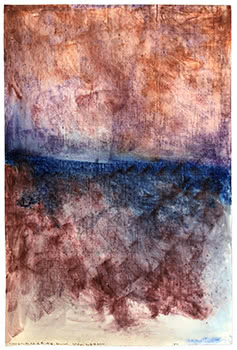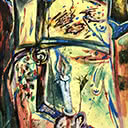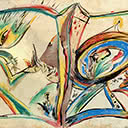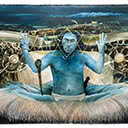View from the Top of the Cliff, Muriwai
109 x 72.5 cm
est. $100,000 - 150,000
PROVENANCE
Private Collection, Auckland
Purchased from John Leech Gallery, c. 1989 by current owner
REFERENCE
McCahon Database www.mccahon.co.nz record number #cm001397
EXHIBITED
Earth/Earth
Barry Lett Galleries Auckland
19/4/1971 - 30/4/1971
Six identically titled and dated works - Muriwai, March, April 1971 - were included in Earth/Earth
The present work was No. 1 from that exhibition
This watercolour was part of a 1971 exhibition at Barry Lett Galleries, called Earth/Earth. For his part, McCahon exhibited six identically titled and dated works alongside landscape paintings by Michael Illingworth, Don Binney, Michael Smither and Toss Woollaston. The catalogue was impressive, capturing a formative moment in New Zealand's art history. These were five influential artists at the forefront of modern art, united in channeling their environmental activism through art. The message was one of beauty, endurance and, as the catalogue described it, "a chorus of protest".
Some years earlier in 1967, Barry Lett Galleries held another exhibition of McCahon's work, a solo show titled North Otago Landscapes. While these earlier landscapes bear similarities to the Muriwai watercolours (it is impossible not to be struck by the sublime fields of colour, or the narrative and metaphoric significance of their vast landforms), the viewer may also be inclined to trace the shift in McCahon's practice over this period. The comparison highlights the profound spiritual and artistic clarity of the 1971 watercolours.
In View from the Top of the Cliff, Muriwai, McCahon fragments and blurs the boundaries of sea, sky and land. Facets of light rendered in raw, earthy tones recall his kauri paintings of the 1950s. The harmony of colour and composition in this work is paradoxical: it conveys protest and unrest.
This is the product of McCahon internalising his landscape, and his ongoing rejection of the tradition of European landscape painting and its picturesque ideals. The artist's own mind; his unique impressions and spiritually grounded relationship with Muriwai have been turned outwards into this painting. McCahon upheld the act of painting as a sensory, essential gesture. At the same time, his internal consciousness was deeply connected to the land and environmental concerns of the moment.
From this point, the artist returned time and time again to paint Muriwai, using the landscape as the basis for his Necessary Protection series which he also started in 1971. He continued to explore the fragility of the Muriwai coast, both as a transcendent, resilient force, and a landscape under threat as we encounter it here.
As in the name of the exhibition, Earth/Earth there is repetition in McCahon's creation and simultaneous exhibition of these six Muriwai works. One may think of this repetition as an artistic rhythm of sorts: the beat of a protest drum, or the sublime meditative state of sky blending into sea into land - a converging state of environmental warning and precious degradation.





